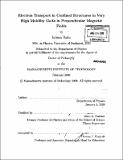Electron transport in confined structures in very high mobility GaAs in perpendicular magnetic fields
Author(s)
Radu, Iuliana
DownloadFull printable version (47.18Mb)
Other Contributors
Massachusetts Institute of Technology. Dept. of Physics.
Advisor
Marc A. Kastner.
Terms of use
Metadata
Show full item recordAbstract
In this thesis we study properties of two-dimensional electron transport through constrictions in perpendicular magnetic fields. We present two sets of experiments, one focusing on properties in the integer quantum Hall effect the second looking at properties in the fractional quantum Hall effect at filling fraction v = 5/2. Both sets of experiments employ electrostatically defined quantum point contacts (QPCs) fabricated on a high mobility GaAs/AlGaAs two-dimensional electron gas (2DEG). In the first set of experiments, we study the suppression of the spin splitting of the Landau levels in QPCs compared to the bulk 2DEG. By using QPCs with different lithographic widths and varying the voltage applied on the gates, we can control the width of the conduction channel from ~3000 to ~100 nm. The width of the channel is estimated from the low magnetic field dependence of the conductance through the QPC. We study the suppression of the spin-splitting of the Landau levels as a function of the effective width of the QPC and measure the number of channels of conduction Ns, above which the spin-splitting is no longer observed. We find that Ns is approximately half of the number of quantized channels in the QPC for all widths less than approximately 1200 nm. For the same width range, we show that the cyclotron diameter at the lowest magnetic field where the spin splitting is resolved is half of the effective width of the QPC. In the second set of experiments, in the fractional quantum Hall regime at v = 5/2, QPCs are used to bring counter-propagating edge states close enough that quasiparticles can tunnel between them. ₂(cont.) Weak quasiparticle tunneling has been long proposed as a method to study the properties of these quasiparticles, because the tunneling conductance depends on both the charge of the tunneling quasiparticles and the modified Coulomb interaction that characterizes their interactions. Several models have been proposed to describe the state at v = 5/2; some predict non-abelian statistics, while others predict the more mundane abelian properties. Although all models predict the same quasiparticle charge e* = 1/4, they predict different values of the interaction parameter, thus allowing us to potentially discriminate between them. We study the temperature and dc bias dependence of the tunneling conductance, while preserving the same filling fraction in the constriction and the bulk of the sample. The data show scaling of the bias-dependent tunneling over a range of temperatures, in agreement with the theory of weak quasiparticle tunneling, allowing us to extract values for the effective charge and interaction parameter of the quasiparticles. The ranges of values obtained are consistent with those predicted by the anti-Pfaffian and the U(1) x SU₂(2) models, making these non-abelian states more likely than abelian ones.
Description
Thesis (Ph. D.)--Massachusetts Institute of Technology, Dept. of Physics, 2009. Cataloged from PDF version of thesis. Includes bibliographical references (p. 105-116).
Date issued
2009Department
Massachusetts Institute of Technology. Department of PhysicsPublisher
Massachusetts Institute of Technology
Keywords
Physics.